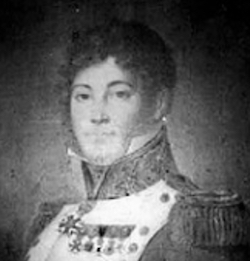General Jean Louis Gros

Born: May 3, 1767
Place of Birth: Montolieu, Aude, France
Died: May 10, 1824
Place of Death: Paris, France
Arc de Triomphe: GROS on the east pillar
Pronunciation:
The son of a refiner, Jean Louis Gros first joined the army in October of 1785 when he joined the chasseurs à pied of Cévennes. Two years later he was promoted to sergeant and then in 1789 he obtained permission to leave the army. In 1791 Gros returned to the army as a lieutenant in the 2nd Battalion of Volunteers of Aude. In 1793 he began serving with the Army of the Eastern Pyrenees and he was promoted to capitaine. Next Gros fought near Céret where he was wounded by a saber blow and later he took part in the Siege of Roses where his right thigh was shattered. In June of 1795 he was again wounded, this time at the affair of Bascara. At the end of that year Gros joined the Army of Italy and in March of 1796 he became a capitaine of grenadiers in the 4th Demi-Brigade of the Line. He served throughout the campaign that year and in August he was wounded by a shot to the right leg at Castiglione. In September Gros served at the Battle of Bassano where he was promoted to chef de bataillon on the battlefield. A week later he fought at the combat of Saint-Georges where his right foot was wounded by a ball. In November Gros was again wounded when he fought at Caldiero. In March of 1797 he served at the Battle of Tagliamento. Three years later in 1800 Gros joined the Army of the Rhine and that May he served at Biberach.
Gros was appointed to the Chasseurs à Pied of the Consular Guard in November of 1803 and only a few months later he was appointed major. He was named a Commander of the Legion of Honor in June of 1804. Serving with the Imperial Guard, Gros took part in the campaign of 1805 against the Third Coalition. Afterwards he was promoted to major-colonel of the 1st Chasseurs à Pied of the Imperial Guard. He continued to serve with the Grande Armée and the Imperial Guard for the War of the Fourth Coalition in 1806 and 1807 and after the conclusion of that war he was promoted to général de brigade in July of 1807. More rewards followed as Gros was named a Knight of the Iron Crown at the end of 1807 and a Baron of the Empire in June of 1808.
Austria declared war on France and her allies in April of 1809 and Gros took command of a brigade of fusiliers of the Imperial Guard in Curial's division. He served at the Battle of Aspern-Essling in May where he was wounded by a shot. In July Gros began serving in the Old Guard under General Dorsenne. In 1810 Gros was sent to Spain with a detachment of the Imperial Guard. Two years later in 1812 he took part in the campaign against Russia. In 1813 Gros participated in the campaign in Saxony as part of the Imperial Guard and that August he took command of the 1st Brigade of the 3rd Division of the Young Guard. Less than two weeks later he fought at the Battle of Dresden where he was wounded by the blow of a bayonet to the thigh. Gros continued to fight and in October he served at the Battle of Leipzig where he was wounded by a shot to the left leg. For the defense of France of 1814, he served in Christiani's division in Champagne.
After Napoleon's abdication and the Bourbon Restoration, Gros was put on non-activity and named a Knight of Saint Louis. He retired from the army in December of 1814 but he returned to duty once Napoleon resumed power in 1815 for the Hundred Days. Gros commanded a brigade of federal tirailleurs of the National Guard of Paris in June and he retired from the army again in August.
Bibliography
Updated September 2020
© Nathan D. Jensen